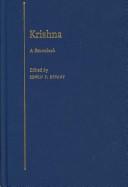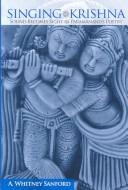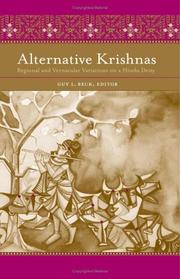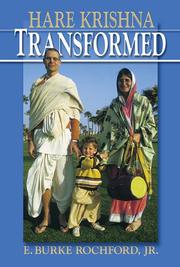| Listing 1 - 7 of 7 |
Sort by
|
Book
ISBN: 0190451955 1282235311 9786612235313 019970600X 9780199706006 9780195373981 0195373987 9780195373998 0195373995 9780190451950 9781282235311 6612235314 Year: 2009 Publisher: Oxford ; New York : Oxford University Press,
Abstract | Keywords | Export | Availability | Bookmark
 Loading...
Loading...Choose an application
- Reference Manager
- EndNote
- RefWorks (Direct export to RefWorks)
Surdas is unarguably the best known poet in Vrajbhasha, the most widely understood of the medieval Hindi literary dialects. In this volume, Jack Hawley offers a selection of his charming translations of the most appealing of these poems.
Krishna --- Christna --- Gopal --- Kr̥ṣṇa --- Govinda --- Mohan --- Gopala --- Bal Gopal --- Krishna (Hindu deity) --- Krishna - (Hindu deity) - Poetry --- Krishna - (Hindu deity)
Book
ISBN: 1282818457 9786612818455 0253004624 1441669736 9781441669735 661281845X 9780253354785 0253354781 9780253221988 0253221986 9780253004628 9781282818453 Year: 2010 Publisher: Bloomington : Indiana University Press,
Abstract | Keywords | Export | Availability | Bookmark
 Loading...
Loading...Choose an application
- Reference Manager
- EndNote
- RefWorks (Direct export to RefWorks)
Since ancient times, Hindus have expressed their love and devotion to their deities through beautiful ornamentation -- dressing and decorating the deities with elaborate clothing, jewelry, and flowers. In this pioneering study of temples in Vrindaban and Jaipur, India, Cynthia Packert takes readers across temple thresholds and into the god Krishna's sacred domain. She describes what devotees see when they behold gorgeously attired representations of the god and why these images look the way they do. She discusses new media as well as global forms of devotion popular in India and abroad. The Art of Loving Krishna opens a universe of meaning in which art, religious action, and devotion are dynamically intertwined.
Krishna (Hindu deity) --- Hindu decoration and ornament --- Hindu temples --- Cult. --- Krishna

ISBN: 1281158879 9786611158873 0198034008 0199724318 1435609506 9780199724314 9780198034001 9780195148916 0195148916 9780195148923 0195148924 9781281158871 9781435609501 0195148916 0195148924 Year: 2007 Publisher: New York : Oxford University Press,
Abstract | Keywords | Export | Availability | Bookmark
 Loading...
Loading...Choose an application
- Reference Manager
- EndNote
- RefWorks (Direct export to RefWorks)
Contributors: Vidyut Aklujkar, Paul Arney, Richard Barz, Neelima Shukla Bhatt, Edwin F. Bryant, Francis X. Clooney, S.J., Satyanarayana Dasa, Neal Delmonico, David Haberman, John Stratton Hawley, Alf Hiltebeitel, Steven P. Hopkins, Ekkhard Lorenz, Nancy Martin, Robert N. Minor, Bijoy M. Misra, Vasudha Narayanan, Lance E. Nelson, Graham Schweig, Deepak Sharma, Paul Sherbow, William L. Smith
Devotional literature, Indic. --- Indic devotional literature --- Indic literature --- Krishna --- Christna --- Gopal --- Kr̥ṣṇa --- Govinda --- Mohan --- Gopala --- Bal Gopal --- Krishna (Hindu deity)
Book
ISBN: 0691639590 0691014191 1400859123 0691064709 1306987016 9781306987011 9781400859122 9780691639598 9780691014197 Year: 2014 Publisher: Princeton, NJ : Princeton University Press,
Abstract | Keywords | Export | Availability | Bookmark
 Loading...
Loading...Choose an application
- Reference Manager
- EndNote
- RefWorks (Direct export to RefWorks)
Every year thousands of pilgrims travel to Brindavan, the village where Krishna is said to have lived as a child. There, they witness a series of religious dramas called ras lilas, whose central roles are performed by children. By translating four plays that collectively span this cycle, John Hawley provides a lively perspective on the mythology of Krishna as Hindus experience it today.Originally published in 1981.The Princeton Legacy Library uses the latest print-on-demand technology to again make available previously out-of-print books from the distinguished backlist of Princeton University Press. These editions preserve the original texts of these important books while presenting them in durable paperback and hardcover editions. The goal of the Princeton Legacy Library is to vastly increase access to the rich scholarly heritage found in the thousands of books published by Princeton University Press since its founding in 1905.
Folk drama, Braj --- Krishna (Hindu deity) --- Drama. --- Translations into English. --- Braj folk drama --- Braj drama --- Krishna --- Christna --- Gopal --- Kr̥ṣṇa --- Govinda --- Mohan --- Gopala --- Bal Gopal --- Translations into English

ISBN: 0791478629 1435641248 9781435641242 0791473953 9780791473955 9780791478622 9780791478622 Year: 2008 Publisher: Albany : State University of New York Press,
Abstract | Keywords | Export | Availability | Bookmark
 Loading...
Loading...Choose an application
- Reference Manager
- EndNote
- RefWorks (Direct export to RefWorks)
"Singing Krishna introduces Paramanand, one of north India's greatest medieval poet-saints, whose poetry has been sung from the sixteenth century to the present in ritual service to the Hindu deity Krishna. A. Whitney Sanford examines how hearing Paramanand's poetry in ritual context serves as a threshold for devotees between this world and Krishna's divine world. To "see Krishna" is a primary goal of the devotee, and Paramanand deftly constructs a vision through words. Sanford employs the dual strategies of interpreting Paramanand's poems - which sing the cycles of Krishna's activities - and illustrating the importance of their ritual contexts. This approach offers insight into the nature of the devotional experience that is not accessible by simply studying the poetry or rituals in isolation. Sanford shows that the significance of Paramanand's poetry lies not only in its beauty and historical importance but finally in its capacity to permit the devotee to see through the ephemeral world into Krishna's world."--book jacket
Paramāṇandadāsa, --- Krishna --- Christna --- Gopal --- Kr̥ṣṇa --- Govinda --- Mohan --- Gopala --- Bal Gopal --- Paramāṇanda Dāsa, --- Parmananddas, --- Paramānand, --- Criticism and interpretation. --- In literature. --- Krishna (Hindu deity) in literature. --- Paramanandadasa,

ISBN: 079148341X 1423744063 9781423744061 0791464156 9780791464151 9780791483411 Year: 2005 Publisher: Albany : State University of New York Press,
Abstract | Keywords | Export | Availability | Bookmark
 Loading...
Loading...Choose an application
- Reference Manager
- EndNote
- RefWorks (Direct export to RefWorks)
Krishna—widely venerated and adored in the Hindu tradition—is a deity of many aspects. An ancient manifestation of the Supreme God Vishnu, or the Godhead itself, Krishna is the bringer of Yoga philosophy and the creator of the universe, the destroyer of evil tyrants, and the hero of the epic Mahabharata. He is also described in classical Sanskrit texts as having human characteristics and enjoying very human pursuits: Krishna is the butter thief, cowherd, philanderer, and flute player. Yet even these playful depictions are based upon descriptions found in the Sanskrit canon, and mostly reflect familiar, classical Pan-Indian images.In this book, contributors examine the alternative, or unconventional, Krishnas, offering examples from more localized Krishna traditions found in different regions among various ethnic groups, vernacular language traditions, and remote branches of Indian religions. These wide-ranging, alternative visions of Krishna include the Tantric Krishna of Bengal, Krishna in urban women's rituals, Krishna as monogamous husband and younger brother in Braj, Krishna in Jainism, Krishna in Marathi tradition, Krishna in South India, and the Krishna of nineteenth-century reformed Hinduism.
Hinduism --- Customs and practices. --- Krishna --- Christna --- Gopal --- Kr̥ṣṇa --- Govinda --- Mohan --- Gopala --- Bal Gopal --- Cult. --- Krishna (Hindu deity) --- Radha --- Vaishnava Sahajiya Tantric traditions --- Vaishnavism --- the Thakur Pancayat --- Krishna statues --- Hindu women --- ritual tradition --- Radhavallabha Sampradaya --- Dauji --- Balarama --- Pandharpur --- early medieval South India --- Vasudeva Krishna --- Jaina cosmohistory --- Radha's Arbor --- Bhakti --- Hariaudhi's Priyapravas --- Holi

ISBN: 0814776884 0814769071 1435607392 9781435607392 9780814775783 0814775780 9780814775790 0814775799 9780814769072 9780814776889 Year: 2007 Publisher: New York : New York University Press,
Abstract | Keywords | Export | Availability | Bookmark
 Loading...
Loading...Choose an application
- Reference Manager
- EndNote
- RefWorks (Direct export to RefWorks)
Most widely known for its adherents chanting “Hare Krishna” and distributing religious literature on the streets of American cities, the Hare Krishna movement was founded in New York City in 1965 by A. C. Bhaktivedanta Swami Prabhupada. Formally known as the International Society for Krishna Consciousness, or ISKCON, it is based on the Hindu Vedic scriptures and is a Western outgrowth of a popular yoga tradition which began in the 16th century. In its first generation ISKCON actively deterred marriage and the nuclear family, denigrated women, and viewed the raising of children as a distraction from devotees' spiritual responsibilities. Yet since the death of its founder in 1977, there has been a growing women’s rights movement and also a highly publicized child abuse scandal. Most strikingly, this movement has transformed into one that now embraces the nuclear family and is more accepting of both women and children, steps taken out of necessity to sustain itself as a religious movement into the next generation. At the same time, it is now struggling to contend with the consequences of its recent outreach into the India-born American Hindu community. Based on three decades of in-depth research and participant observation, Hare Krishna Transformed explores dramatic changes in this new religious movement over the course of two generations from its founding.
Hindu converts --- Hinduism --- Families --- Converts --- Hindus --- Religions --- Brahmanism --- Family --- Family life --- Family relationships --- Family structure --- Relationships, Family --- Structure, Family --- Social institutions --- Birth order --- Domestic relations --- Home --- Households --- Kinship --- Marriage --- Matriarchy --- Parenthood --- Patriarchy --- Religious aspects --- International Society for Krishna Consciousness. --- Social aspects --- Social conditions --- Krishna --- Christna --- Gopal --- Kr̥ṣṇa --- Govinda --- Mohan --- Gopala --- Bal Gopal --- Cult --- International Society for Krishna Consciousness --- International Society for Krsna Consciousness --- Internationale gemeenschap voor Krishna-bewustzijn --- History. --- Krishna (Hindu deity) --- Based. --- Hare. --- Krishna. --- Transformed. --- changes. --- course. --- decades. --- dramatic. --- explores. --- founding. --- from. --- generations. --- in-depth. --- movement. --- observation. --- over. --- participant. --- religious. --- research. --- this. --- three. --- Hare krishna --- America --- gender --- family --- culture --- change --- child abuse --- public schooling --- identity --- Hinduization --- world accomodation
| Listing 1 - 7 of 7 |
Sort by
|

 Search
Search Feedback
Feedback About UniCat
About UniCat  Help
Help News
News